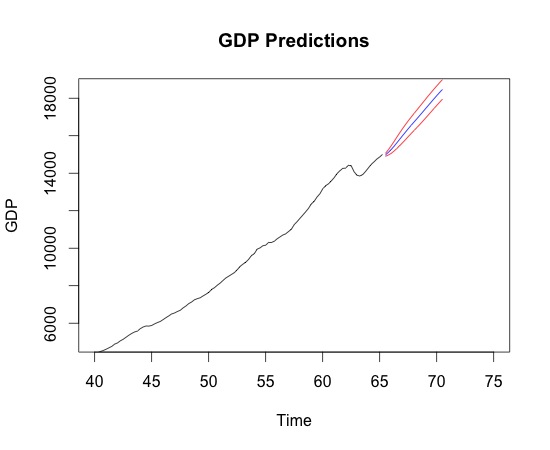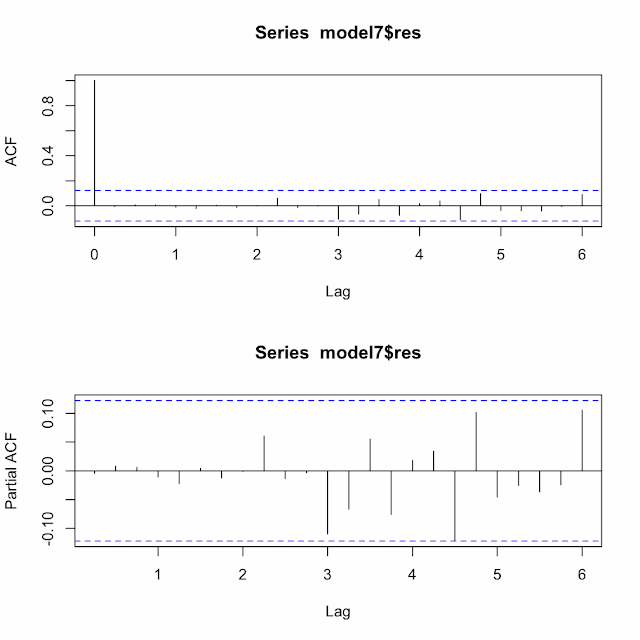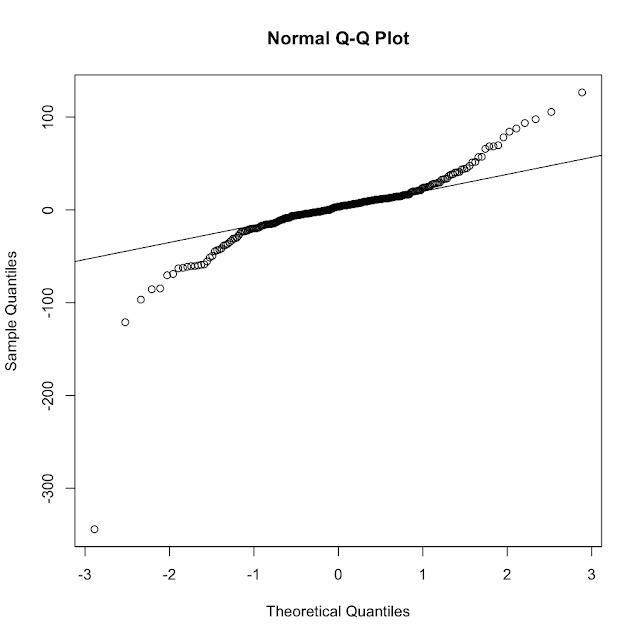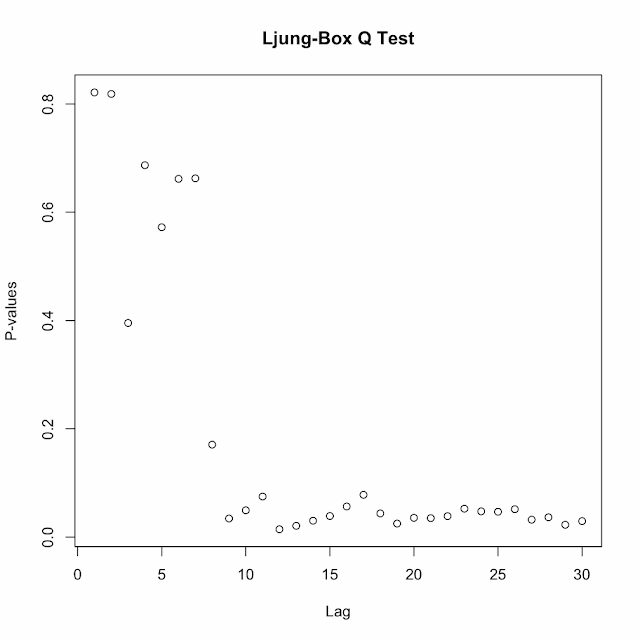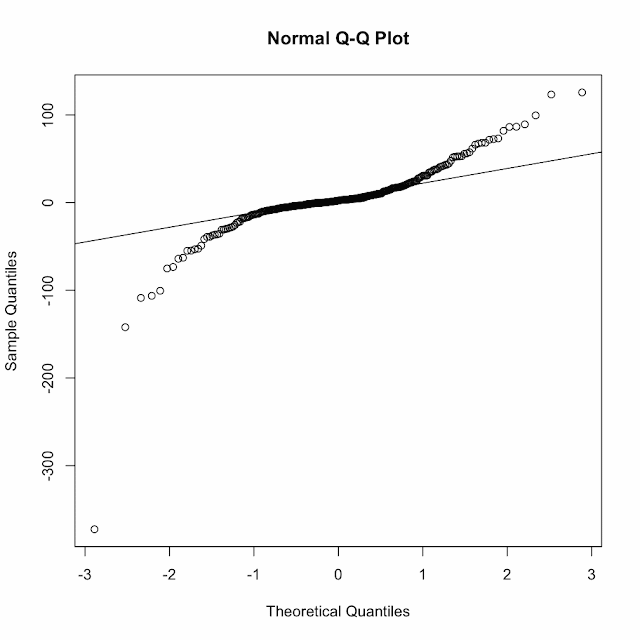1. Estimate the OLS regression
2. Fit OLS residual to an AR(p) process using the Yule-Walker Method and find the value of p.
3. Re-estimate model using Generalized Least Squares fit by Maximum Likelihood estimation, using the estimated p from 2, as the order for your correlation residual term.
4. Fit the GLS estimated residuals to an AR(p) process using the Yule-Walker Method and use the estimated p's as the final parameter estimates for the error term.
The end goal of the above procedure is to have our models be asymptotically BLUE or the Best Linear Unbiased Estimators. The implies that they have the smallest variance out of all the models that meet the rest of the Gauss-Markov assumptions. A little background behind the methodology is in order. First we will perform the standard Ordinary Least Squares (OLS) regression on our dependent variables. This will give us at the very least unbiased estimators. Second we take the residuals from the first step and fit them to an AR(p) process as selected by the Yule-Walker Method. This method selects the optimal lag that characterizes the autocorrelation in the residuals. We automatically take this step, due to the well known fact that most time-series suffer from autocorrelation problems as verified by our correlograms. Then we re-estimate the regression using Generalized Least Squares which adjusts each term and divides them by their individual variances, while also incorporating the AR(p) lag that we discovered during the previous step. The final step, which fits our GLS models residuals to an AR(p) process is what leads to our asymptoticly efficient results. We lay out our first estimation period models below.
First Estimation: 4/1/71 to 7/1/97
1. Monetary Policies Impact On Short-term Risk Premiums
Our first model which seeks to answer how monetary policy impacts the risk premia on short-term commercial paper as estimated over our first time period 4/1/71 to 7/1/97 is as follows:
SR^{premium}_{t}=ß_{0}+ß_{1}*FedBalance^{size}_{t}+ß_{2}*Support_{t} + ß_{3}*UGAP_{t}+ ß_{4}*FF_{t}+ ß_{5}*ER_{t}+ ß_{6}*YC_{t}+ ß_{7}*Default^{spread}_{t}+ ß_{8}*CP_{t}+ ß_{9}*OGAP_{t} + ß_{10}*FedGDP_{t}+ ß_{11}*govcredit_{t}+ ß_{12}*ForeignDebt_{t} + µ_{t}
Where,
SR^{premium}_{t} = Short-term Risk Premium at time, t
Support_{t}= Fed's funds at depository institutions as a percentage of their main financing streams at time, t
FedBalance^{size}_{t}= The Fed's credit market asset holdings as percentage of the total credit market assets at time, t
FF_{t}= Federal Funds rate at time, t
ER_{t}= Excess Reserves of Depository Institutions at time, t
YC_{t}= Yield curve at time, t
Default^{spread}_{t}= Default Spread between BAA_{t} & AAA_{t} rated bonds at time, t
CP_{t} = Corporate Profits After Tax at time, t
FedGDP_{t}= Fed's holdings of total public debt as a percentage of GDP at time, t
govcredit_{t}= Government Holdings Of Domestic Credit Market Debt As A Percentage Of The Total at time, t
ForeignDebt_{t}= Foreign Holdings of Federal Debt As A Percentage Of The Total at time, t
UGAP_{t} = Unemployment gap at time, t
OGAP_{t} = Output gap at time, t
µ_{t}= error term at time, t
R DATA WORK
So now it is time for the long awaited econometrics work in R. First thing you'll want to do is read the data into R from your data file which is in this case is the Earlreg file.
> earl<- read.csv("/Users/stevensabol/Desktop/R/earlreg.csv",header = TRUE, sep = ",")
Then you define your variable names so you can easily manipulate your data in R. So when you open the official .csv data file take a look at the variable names and rename them using the following procedure.
>yc1<-earl[,"yc"]
After you define what you call everything you're then free to go crazy and run regressions. Below is how you run the standard Ordinary Least Squares regression. The lm function enables you to run linear regressions:
1. Estimate the OLS regression
>srp1.lm=lm(srp1~yc1+CP1+FF1+default1+Support1+ER1+FedGDP1+FedBalance1+govcredit1+ForeignDebt1+UGAP1+OGAP1)
In order to get the output you have to use the summary function:
> summary(srp1.lm)
Call:
lm(formula = srp1 ~ yc1 + CP1 + FF1 + default1 + Support1 + ER1 +
FedGDP1 + FedBalance1 + govcredit1 + ForeignDebt1 + UGAP1 +
OGAP1)
Residuals:
Min 1Q Median 3Q Max
-1.04289 -0.20145 -0.04041 0.15230 1.21044
Coefficients:
Estimate Std. Error t value Pr(>|t|)
(Intercept) -2.7591194 1.0359966 -2.663 0.00912 **
yc1 0.1320996 0.0580500 2.276 0.02516 *
CP1 -0.0022773 0.0073773 -0.309 0.75825
FF1 0.1699788 0.0340654 4.990 2.81e-06 ***
default1 0.4382965 0.1876685 2.335 0.02167 *
Support1 2.2383850 0.6660140 3.361 0.00113 **
ER1 0.3351508 0.3017644 1.111 0.26959
FedGDP1 0.3031938 0.2558144 1.185 0.23895
FedBalance1 0.4014920 0.3477547 1.155 0.25124
govcredit1 -0.0928817 0.0401603 -2.313 0.02294 *
ForeignDebt1 -0.0068900 0.0215393 -0.320 0.74977
UGAP1 -0.0912273 0.0520491 -1.753 0.08295 .
OGAP1 0.0006669 0.0014895 0.448 0.65536
---
Signif. codes: 0 ‘***’ 0.001 ‘**’ 0.01 ‘*’ 0.05 ‘.’ 0.1 ‘ ’ 1
Residual standard error: 0.3789 on 93 degrees of freedom
Multiple R-squared: 0.6474, Adjusted R-squared: 0.6019
F-statistic: 14.23 on 12 and 93 DF, p-value: 2.642e-16
Next we perform step 2 which is:
2. Fit OLS residual to an AR(p) process using the Yule-Walker Method and find the value of p.
> srp.lmfit<-ar.yw(srp1.lm$res)
> srp.lmfit
Call:
ar.yw.default(x = srp1.lm$res)
Coefficients:
1
0.2535
Order selected 1 sigma^2 estimated as 0.1201
So the Yule-Walker methodology fits the residual series to an AR(1) process.
3. Re-estimate model using Generalized Least Squares fit by Maximum Likelihood estimation, using the estimated p from 2, as the order for your correlation residual term.
In order to run a GLS regression your going to need to load the nlme package:
> library(nlme)
Then you can go crazy:
>srp1.gls=gls(srp1~yc1+CP1+FF1+default1+Support1+ER1+FedGDP1+FedBalance1+govcredit1+ForeignDebt1+UGAP1+OGAP1, corr=corARMA(p=1,q=0),method="ML")
> summary(srp1.gls)
The following output is produced:
Generalized least squares fit by maximum likelihood
Model: srp1 ~ yc1 + CP1 + FF1 + default1 + Support1 + ER1 + FedGDP1 + FedBalance1 + govcredit1 + ForeignDebt1 + UGAP1 + OGAP1
Data: NULL
AIC BIC logLik
100.7905 140.7421 -35.39526
Correlation Structure: AR(1)
Formula: ~1
Parameter estimate(s):
Phi
0.3696665
Coefficients:
Value Std.Error t-value p-value
(Intercept) -3.0219486 1.2595942 -2.399145 0.0184
yc1 0.1929605 0.0640627 3.012054 0.0033
CP1 -0.0060642 0.0071791 -0.844700 0.4004
FF1 0.1918066 0.0362894 5.285466 0.0000
default1 0.5292204 0.2060591 2.568293 0.0118
Support1 2.1086204 0.7405128 2.847514 0.0054
ER1 0.5651430 0.2770125 2.040135 0.0442
FedGDP1 0.1028773 0.3143122 0.327309 0.7442
FedBalance1 0.7845392 0.4130914 1.899190 0.0606
govcredit1 -0.1240196 0.0524191 -2.365922 0.0201
ForeignDebt1 0.0009822 0.0278623 0.035252 0.9720
UGAP1 -0.1266050 0.0657633 -1.925161 0.0573
OGAP1 -0.0014094 0.0014328 -0.983623 0.3279
Correlation:
(Intr) yc1 CP1 FF1 deflt1 Spprt1 ER1 FdGDP1 FdBln1 gvcrd1
yc1 -0.267
CP1 0.054 -0.062
FF1 -0.308 0.726 -0.012
default1 0.081 -0.208 0.235 -0.342
Support1 -0.005 -0.109 -0.107 -0.419 0.137
ER1 -0.208 0.077 -0.081 0.067 -0.180 0.028
FedGDP1 -0.728 -0.059 -0.048 0.083 -0.057 -0.002 -0.308
FedBalance1 0.461 0.250 0.020 0.208 0.036 -0.081 0.445 -0.887
govcredit1 -0.570 -0.233 -0.095 -0.291 -0.261 0.072 0.068 0.666 -0.784
ForeignDebt1 -0.475 0.132 0.006 -0.092 0.093 0.219 0.057 0.059 -0.045 0.227
UGAP1 -0.048 -0.193 -0.062 0.085 -0.447 0.150 0.090 0.045 0.064 -0.053
OGAP1 -0.029 0.092 0.295 0.062 -0.208 -0.024 0.053 -0.021 0.013 0.056
FrgnD1 UGAP1
yc1
CP1
FF1
default1
Support1
ER1
FedGDP1
FedBalance1
govcredit1
ForeignDebt1
UGAP1 -0.016
OGAP1 0.064 0.041
Standardized residuals:
Min Q1 Med Q3 Max
-3.08026826 -0.62589269 -0.08409222 0.39781537 3.24233325
Residual standard error: 0.3634024
Degrees of freedom: 106 total; 93 residual
After you perform this step you have to refit the residuals in order to get serially uncorrelated terms.
4. Fit the GLS estimated residuals to an AR(p) process using the Yule-Walker Method and use the estimated p's as the final parameter estimates for the error term.
> s1glsres.ar<-ar.yw(srp1.gls$res)
> s1glsres.ar
Call:
ar.yw.default(x = srp1.gls$res)
Coefficients:
1
0.3718
Order selected 1 sigma^2 estimated as 0.1163
In order to see the results of these actions please refer to image below:
The Ljung-box Q is a test for autocorrelation between the lags in the error terms. Ideally in order to meet the BLUE criteria we have to reject the the null hypothesis for autocorrelation at each lag. We can see that both our original OLS and GLS estimations fail to pass the Ljung-Box Q. However when we readjust the error terms the final time we get residuals that are serially uncorrelated with each other.
In order to get the above graph you have to first load the package that will allow you to perform the Ljung-Box Q plot:
> library(FitAR)
Then you can proceed from there and define how many plots should be in one picture. In the above image we have 9 therefore:
> par(mfrow=c(3,3))
Then you can start adding in your plots. Below is the code for producing the plots for the fitted GLS residuals.
> acf(s1glsres.ar$res[-(1)])
> pacf(s1glsres.ar$res[-(1)])
> LBQPlot(s1glsres.ar$res[-(1)])
We include the [-(1)] because exclude the first observation since we have an AR(1) process.
The same steps above can be applied to any time-series regression model. In the next post we will discuss how to get some summary statistics. Please keep dancin'
Steven J.

